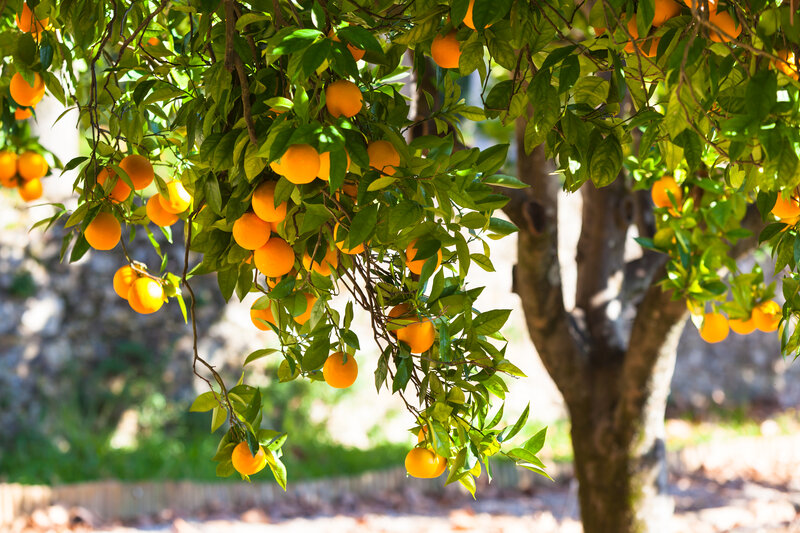CA Contractors #344056

When it comes to sustainable landscape design, we take multiple factors into effect. Preferences go to native plants, drought-resistant species, usable/consumable plants, and those that provide shade and minimize solar heat gain in the home. Fruit trees fall into the last two categories and are some of our favorite trees to plant.
Read What Does it Mean to Build a Sustainable Landscape for more information on that topic.
There are multiple benefits to planting fruit trees in your front, side, or back yard.
If you’ve never visited a “U-Pick” farm or had ripe fruit picked right from the tree, you’re in for a treat. Store-bought fruit is picked and shipped long before it’s ready so that it “ripens” off the tree. While lessening the damage to softer fruits, and timing its “ripe” availability to shoppers, this tactic notably lowers the overall potency of the fruit’s flavor and hinders nutrient values.
In addition to having access to fruit in its prime, you’ll also have an abundant supply to work with. Excess fruit makes great gifts for neighbors is easy to trade with other gardening neighbors who grow different varieties on their lots. Growing your own fruit gives you the ability to make your own canned fruits, fruit sauces, and preserves to enjoy year-round or gift to family members and friends over the holidays. Best of all, you control how the fruit grows and have the ability to grow it 100% pesticide and herbicide-free.
Read our post, Controlling Garden Pests Organically, for more information on eco-friendly pest/weed control.
For the most part, mature fruit trees are a low-maintenance landscape option as long as you select the best types for your location and interests. All require some level of care and pruning, but that is easily handled by a local landscape professional once or twice per year if you don’t want to do that work yourself.
The lowest maintenance trees are persimmon, pomegranate, fig, plums, peaches, cherries, and lemon/lime trees. Some trees require pollinators, others are self-pollinating, so it’s helpful to know the difference (more on that below).
Things to keep in mind:
Your landscape designer or local garden store representative is the best person to help you make decisions about the ideal fruit trees for your property, lifestyle, and goals. While it takes two to three years for most fruit trees to bear fruit, the results are well worth the wait.
Fruit trees make desirable feeding and home sites for native birds, pollinators, and other wildlife. You’ll love watching bees, moths, and butterflies as they busily tap spring fruit tree blossoms for pollen and nectar. Of course, when the fruit comes in, you’ll notice lots of nibbles, but that’s okay. A single, mature fruit tree produces hundreds of pieces of fruit per year, so there’s plenty for everyone and every creature to enjoy.
Fruit trees that rely on pollinators use bees, butterflies, moths, and certain birds to bring pollen to your trees from other fruit trees in the area. Trees that require pollinators include apples, pears, plums, and sweet cherries. Others are self-pollinating, which means you have to have two different trees of the same species. These include apricots, nectarines, peaches, and sour cherries.
You make an active difference in reducing the carbon footprint every time you plant a tree. “Reforestation,” the act of planting new trees, is one of the top three natural solutions to climate change. If you decide not to plant a fruit tree, do make an effort to plant another tree species instead.
Every fruit tree you plant helps to minimize our dependence on fossil fuel consumption. First and foremost, every tree that can be picked and eaten locally reduces the need for transportation fuel. Second, the shade created by your tree, and its support in reducing the urban heat island effect, means less dependence on air conditioning, further contributing to energy savings.
Did you know that a tree’s root system is equally broad and substantial underground as its canopy is above ground? That’s why trees do such a tremendous job of stormwater management. Their extensive root systems, combined with mycelium (fungi) networks and other microbes, hold the earth together. Loose soil is less likely to flood into a yard or out into the street or storm drains of a property flanked by trees. Your new fruit trees will do their part in minimizing erosion and contributing to the neighborhood’s stormwater management systems.
Fruit trees have beautiful blooms, which adds color and visual interest to any landscape. Your garden supply store employees can show you pictures of the fruit trees that do well in your neck of the woods, and you can choose the trees that bloom the most profusely. If placed well, you may even benefit from the heady scent of fruit tree blossoms as they waft on the breeze into your patio and living spaces.
Would you like to learn more about the fruit tree varieties that will flourish where you live? Schedule a consultation with Bay Area Landscapes.